A BIRTHDAY SALUTE: The celebrated Mr. K crosses universes with a DC workhorse…
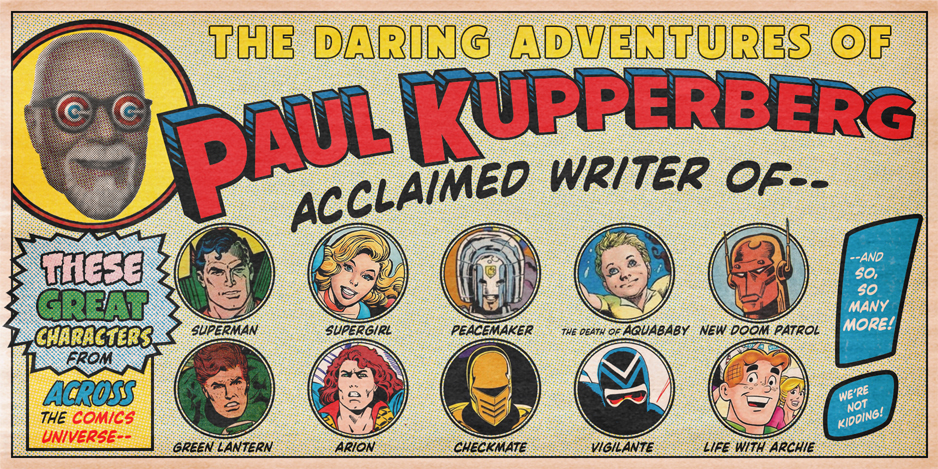
—
UPDATED 12/17/25: The late Dick Dillin was born 97 years ago! Perfect time to reprint this piece from 2020. Dig it. — Dan
—
By PAUL KUPPERBERG
In 1968, Dick Dillin (December 17, 1928 – March 1, 1980), the penciller of DC Comics’ Blackhawk, hovered on the periphery of my comic fan awareness. I was a superhero fan first and foremost, and titles in other genres had to work very hard to get my attention. Blackhawk was somewhere in between superhero and not; created in 1941 for Quality Comics by Chuck Cuidera, Bob Powell and Will Eisner, it was originally a World War II military aviation feature that evolved postwar into an adventure strip.
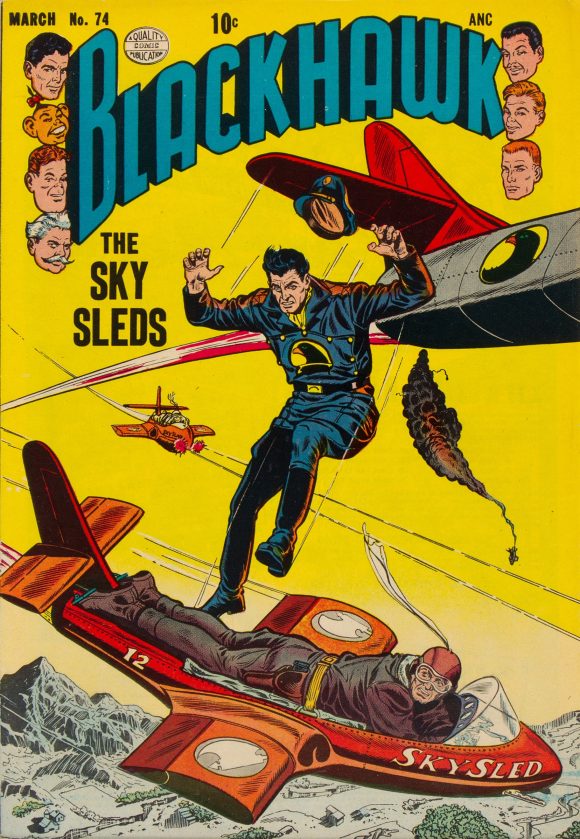
Dick Dillin pencils, Chuck Cuidera inks
When DC acquired the Quality catalogue in 1956, Dillin, who had been penciling the book, came along for the ride. And what a deal! With a solid style and sense of storytelling, Dillin easily accommodated stories crammed with seven regular characters and their Grumman XF5F Skyrocket airplanes without dropping a layout.
Dillin clocked an amazing 177 issues of Blackhawk between 1951 and 1968, when the title’s new editor, Dick Giordano, changed up the creative team. You’d think after his 17-year marathon, anyone would have wanted to take a little break. But not Dick Dillin. Blackhawk #241 was cover-dated June/July 1968; the first issue of his next regular gig, Justice League of America #64 was August 1968. He didn’t even take a month off before diving into what was to become his next long haul; 119 issues over the next dozen years.
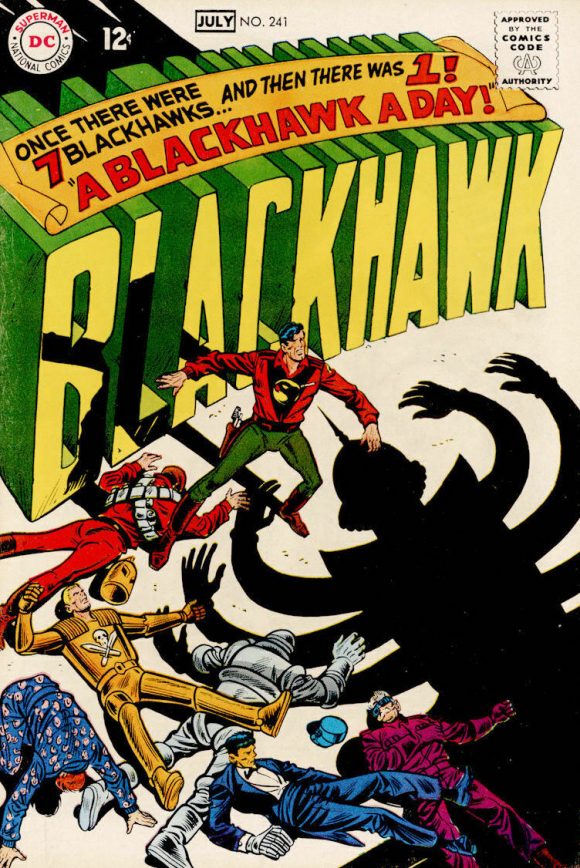
Dillin and Cuidera
Oh, and to make it even crazier, Dillin’s very first issue was Part 1 of the annual JLA/Justice Society of America crossover event, doubling the number of heroes featured in the story! And, as many memorable Dillin-drawn issues as there were, it’s his work on these crossovers that I’m spotlighting here in honor of his birthday.
JLA is a lifelong favorite title of mine, discovered when it was still being drawn by Mike Sekowsky. The annual Earth-One/Earth-Two crossovers with the Golden Age JSA characters (initiated by editor Julie Schwartz and writer Gardner Fox beginning in 1963’s JLA #21–22) became probably the most eagerly awaited event of the DC Comics year.
I’d originally intended to write about the Earth-One/Earth-Two JLA/JSA stories in a column about my 13 favorite DC Golden Age/Silver Age crossover stories (a not-too-subtle promotional nod toward my recently published Justice Society of America novel, JSA: Ragnarok, published by Crazy 8 Press — now available in paperback or eBook on Amazon — but stuff got in my way.
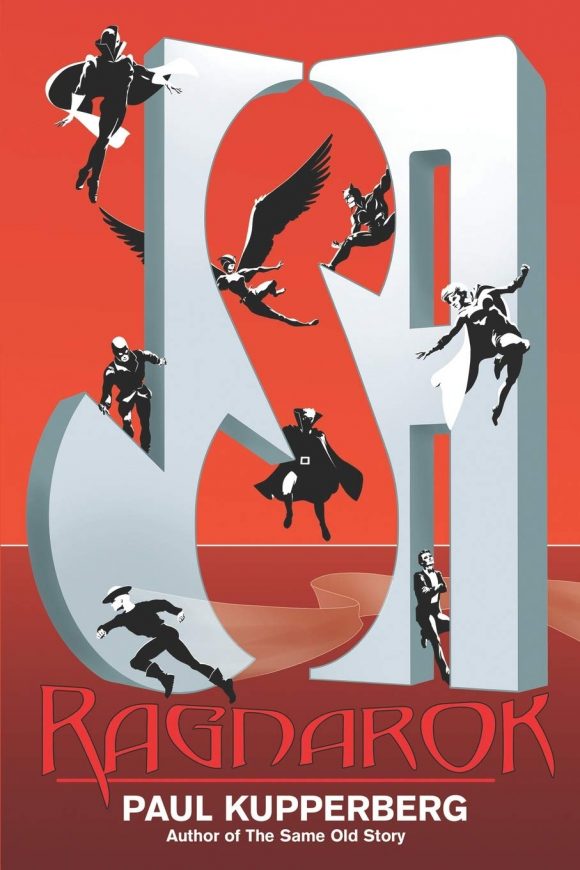
So, in order to have something ready to celebrate Dick Dillin’s birthday, I’m starting in the middle with his run; I’ll work my way back to those earlier stories next time (and probably remind you again about JSA: Ragnarok).
But for now, I give you Dick Dillin, one of comics’ hardest working artists — in chronological order:
—
1. Justice League of America #64-65 (August-September 1968). As noted above, Dillin’s debut issue was Part 1 of the 1968 JLA/JSA crossover event, “The Stormy Return of the Red Tornado” and “T.O. Morrow Kills the Justice League — Today!” Talk about being thrown into the deep end: This Gardner Fox script featured 30 or so distinctively costumed characters over two different worlds and introduced a new, Silver Age superhero iteration of a comedic Golden Age “mystery (wo)man,” Red Tornado.
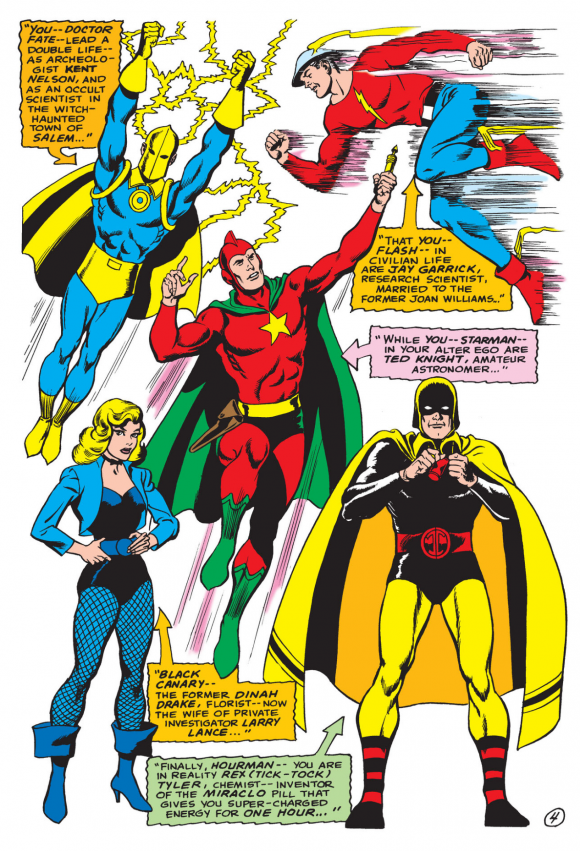
Issue #64, Sid Greene inks.
Dillin was inked here by Sid Greene, likely the first inker other than Blackhawk compatriot Chuck Cuidera to touch his interior pencils in over 15 years. And, just to add an ironic (>gasp! choke!<) little twist, Dillin’s first cover for his first issue of JLA (inked by Jack Abel) doesn’t feature a single member of the JLA itself, except for a couple of pasted-on stock headshots of Batman and Superman around the logo.
—
2. Justice League of America #73-74 (August–September 1969). Another year, another multi-hero crossover, and much like the previous year’s introduction of the new Red Tornado, one with consequences. Longtime JLA (and once upon a time Golden Age JSA) writer Gardner Fox was gone, replaced by the rising star of the new generation of writers, Denny O’Neil. On Earth-Two, a cosmic menace threatens to destroy everything before Red Tornado can escape to Earth-One and bring the JLA back to help.
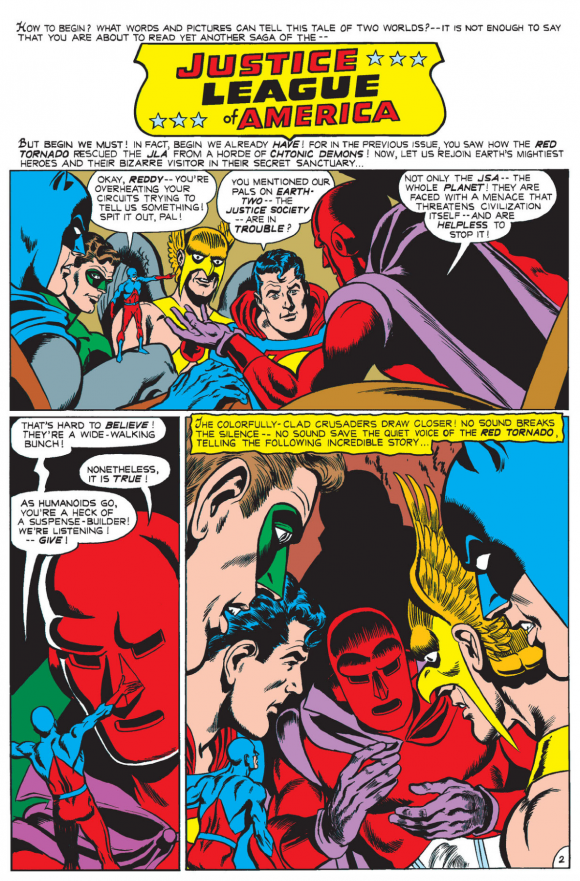
Issue #73, Greene inks.
Did the good guys ultimately win? Of course. It was 1969. The Comics Code Authority insisted. But with victory came the price of the life of Larry Lance, the husband of Dinah Lance/Black Canary and a character first introduced in 1948. Nowadays, characters drop like flies (usually to be resurrected sooner or later), but back then the death of any character was a big deal.
—
3. Justice League of America #75 (November 1969). Not officially a JLA/JSA story, but one featuring an important moment in the development of the Multiverse as Black Canary, a lifelong Earth-Two character, became the first hero to move permanently from one world to another, taking up permanent residence on Earth-One to escape the painful memories of her husband’s death.
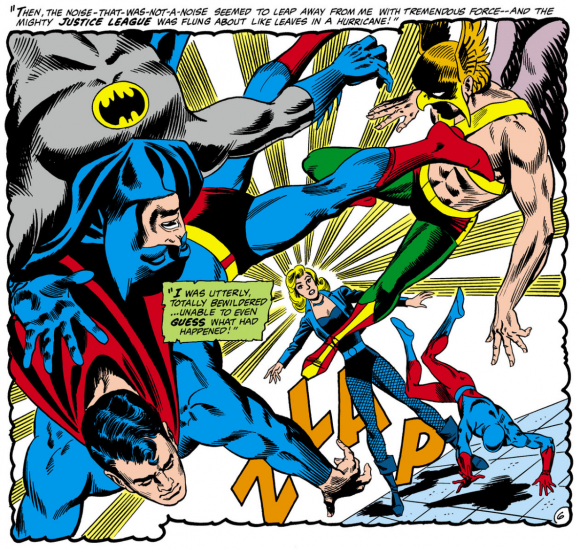
Joe Giella inks
In “In Each Man There is a Demon,” Denny and Dillin provided a powerful story that pit the members of the JLA against evil duplicates of themselves and introduced Black Canary and readers to the power of her “sonic scream,” gained as a result of crossing worlds.
—
4. Justice League of America #78 (February 1970). “The Coming of the Doomsters” doesn’t exactly qualify as an Earth-One/Earth-Two story; I always felt it fell into a vague pre-continuity-crazed area of undeclared Golden Agers. Here, Vigilante (the motorcycle riding Western troubadour Greg Saunders — back-up feature from 1941–54 — not the psychotic killer Adrian Chase I’d later write) is brought out of retirement to help the JLA defeat an environmental menace in a story that also introduced the team’s new satellite headquarters.
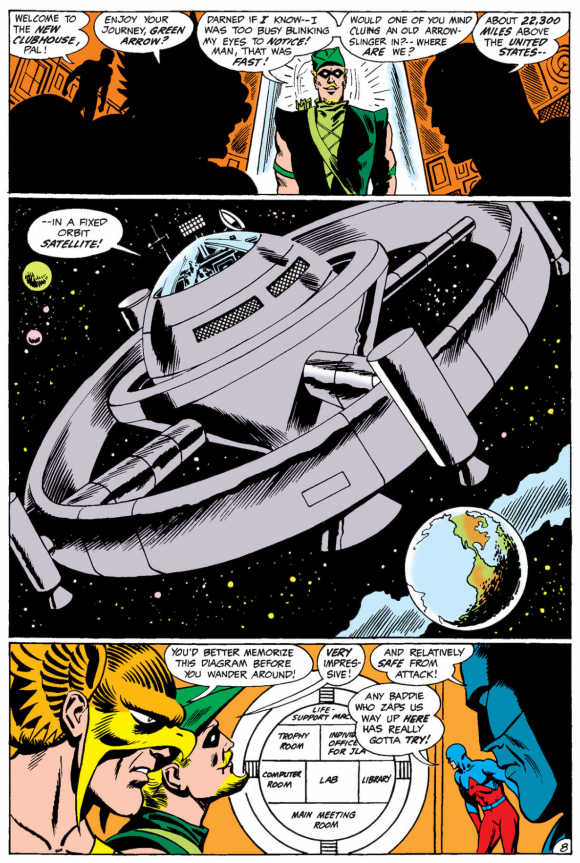
Dillin pencils, Giella inks.
A couple of years later, the JLA would again meet Vigilante, but as a member of the Earth-Two based Seven Soldiers of Victory. Like I said, it could get fuzzy.
—
5. Justice League of America #82-83 (August-September 1970). Red Tornado is once again the bridge between the two Earths as the android is captured by the mysterious Creator2, who uses the android’s vibrational energies to target the heroes of both worlds. When superpowers fail, the JSA turns to magic for salvation.
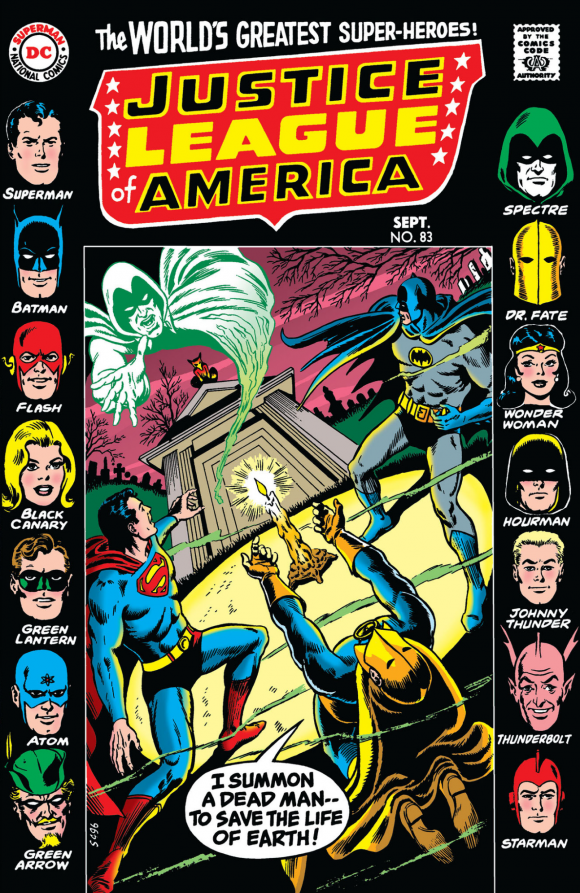
Dillin pencils, Murphy Anderson inks.
As committed a reader as I was to JLA, these crossover stories were starting to lose some of their sizzle. Early on, it was exciting just seeing the Golden Agers resurrected and back in action. But once they had all been rolled out, the stories were getting repetitious: the JLA and JSA versus a big bad menacing both their worlds. And no disrespect to one of the industry’s most celebrated writers, Denny O’Neil, but even he conceded that cosmic superheroics were not his forte. Thank goodness, at least, for the consistent and steady presence of Dick Dillin!
—
6. Justice League of America #91-92 (August-September 1971). It felt as though they’d stopped even bothering coming up with motivations for the crossovers. Here, a trio of joyriding aliens and their symbiotic pets get into an accident in the dimensional barrier between the two Earths and end up fighting the JSA.
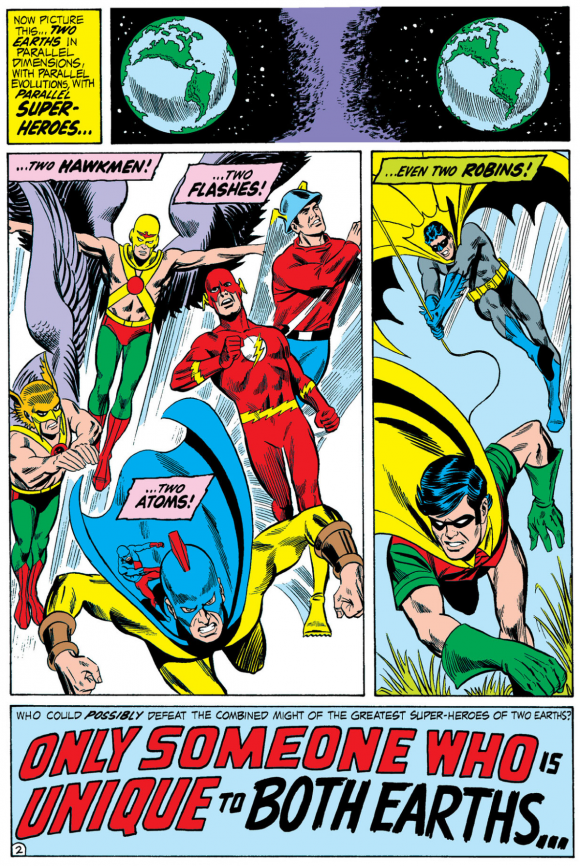
Issue #92, Giella inks.
If “Earth — the Monster Maker” and “Solomon Grundy — the One and Only” showed us anything, it was that the once vaunted “Crisis Crossovers” of yesteryear were caught in the creative doldrums. Dillin had shown from his very first time out on JLA that he could handle all the heroes the writer wanted to throw at him, doing the best with what he was given to draw. I don’t know about Dick, but his fans were still waiting to see him strut his stuff on some stories worthy of his talents.
—
7. Justice League of America #98 (May 1972). But first, another hazy Golden Age/Silver Age character, this time Sargon the Sorcerer, the turbaned magician who made his debut in All-American Comics #26 in 1941 and, abracadabra, disappeared after his strip in Sensation Comics was canceled in 1948.
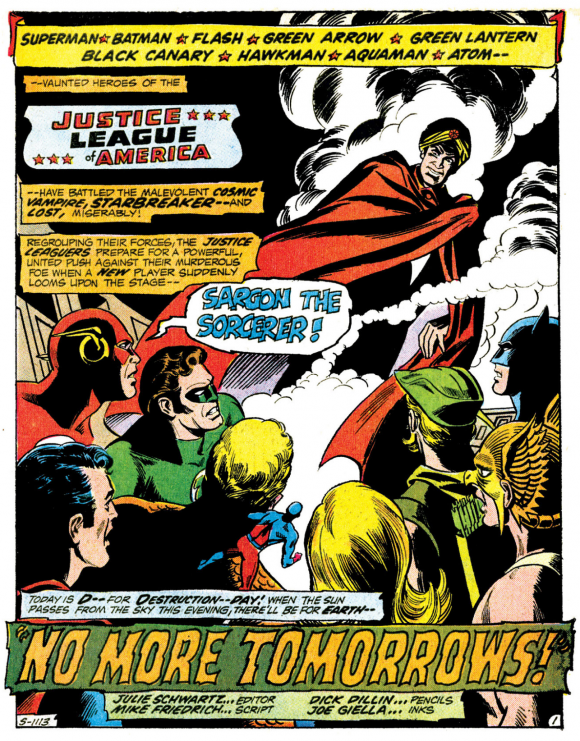
Giella inks
Mike Friedrich had revived Sargon as a villain in The Flash #186 in 1969 (and later in #207) and now gave him a chance at redemption by offering the JLA a supernatural solution to the overwhelming threat of Starbreaker.
—
8. Justice League of America #100–102 (August–October 1972). First there was DC’s Justice Society of America (All-Star Comics #3, Winter 1940)… and only months later, there came DC’s Seven Soldiers of Victory (Leading Comics #1, Summer 1941). The difference? The JSA was made up of the publisher’s A-team characters, while the Soldiers were solid second stringers: Green Arrow and Speedy, the Shining Knight, the Crimson Avenger, Vigilante, and the Star-Spangled Kid and Stripesy.
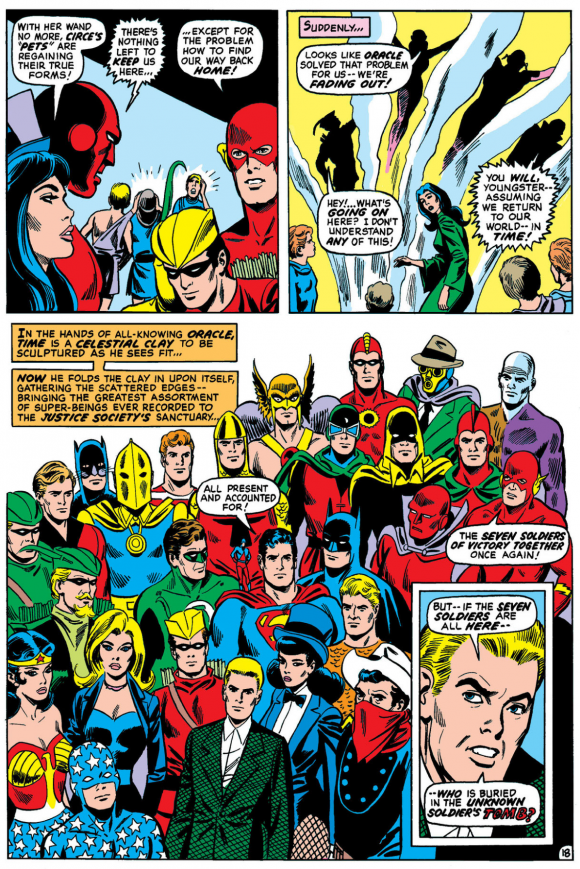
Issue #102. Probably Giella inks.
The 100th issue of Justice League and 10th annual JLA/JSA crossover marked writer Len Wein’s debut on the title. And his two-parter, “The Unknown Soldier of Victory” and “The Hand That Shook the World,” shook up readers, especially those of us familiar with the Soldiers (my best friend had all 14 of their Golden Age appearances in Leading Comics).
As I said, the thrill of the original “Crisis Crossovers” was the re-introduction of all those long ago or lost heroes into modern continuity. Len, himself only a few years out of fandom, remembered that thrill and breathed new life into the concept with this eagerly anticipated epic that teased the death of one of the Soldiers… OK, it turned out to be Shining Knight’s horse Winged Victory, but still.
—
9. Justice League of America #107–108 (September/October–November/December 1973). How did Wein and Dillin hope to out-do the previous year’s Seven Soldiers crossover? By reaching beyond Earth-One and Earth-Two, beyond even the realm of DC’s Golden Age and into the Quality Comics superheroes from the 1940s, now natives of Earth-X, an alternative universe where the Nazis won World War II.
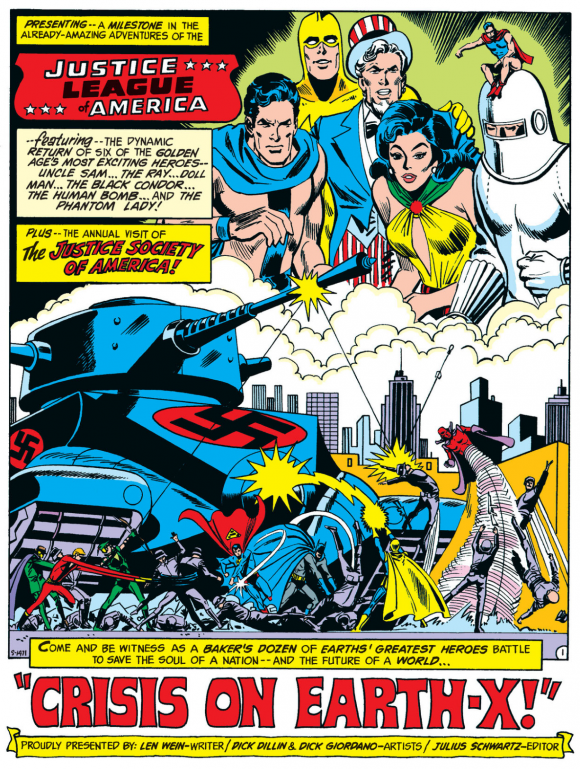
Issue #107, Dick Giordano inks.
Quality Comics published a wide range of comics until 1956 when it sold the copyrights and trademarks to many of their properties to DC, including the Dick Dillin Blackhawk. DC didn’t do anything with most of the characters besides Blackhawk, except for Plastic Man during the ’60s.
Len couldn’t resist a roster of heroes like Uncle Sam, the Human Bonb, Phantom Lady, Dollman, the Ray and Black Condor, giving a modern spin on their World War II origins as the Freedom Fighters. And, once again, there was Dick Dillin delivering the goods and reintroducing another subset of classic heroes to the modern audience, this time inked by Dick Giordano’s clean, crisp line.
—
10. Justice League of America #123-124 (October-November 1975). Things got seriously meta and self-referential in 1975’s “Where on Earth am I?” and “Avenging Ghosts of the Justice League,” by the writing team of Cary Bates and Elliot Maggin. Jumping off from earlier Flash stories in which it was established there was an Earth-Prime (i.e., the one we lived on, where these comic books were being published), we meet the young scribes in the throes of plotting the next issue of JLA, i.e., the one we were reading.
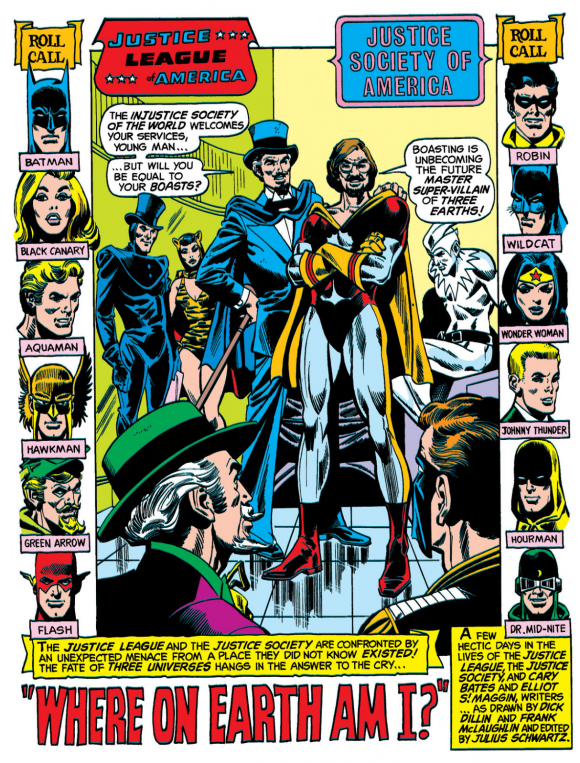
Issue #123, Frank McLaughlin inks.
The lads stumble upon the Flash’s time-traveling Cosmic Treadmill (the one left behind in editor Julie Schwartz’s closet in 1968), Cary is accidentally sent to Earth-Two, where he becomes a villain when he’s brainwashed by the Wizard and the Injustice Society, and Elliot follows him across interdimensional space to alert the Justice League and stop his collaborator from doing anything rash.
It was weird, but Dick Dillin not only kept the story on track with his clean layouts and storytelling, he managed to provide very convincing likenesses of its two Earth-Prime protagonists.
—
11. Justice League of America #135–137 (October-December 1976). Once Len Wein opened the door to adding worlds to the ever-expanding Multiverse, I just know E. Nelson Bridwell had to be champing at the bit to add Earth-S, the world of his much beloved original Captain Marvel to the mix. He got his chance, with scripter Martin Pasko, in 1976’s epic three-part crossover, “Crisis in Eternity,” “Crisis on Earth-S,” and “Crisis in Tomorrow.” (I don’t have to explain the whole DC Comics/Fawcett Comics lawsuit/subsequent acquisition of Fawcett characters, etc. thing, or the fact that he was still allowed to be called Captain Marvel back then, do I?)
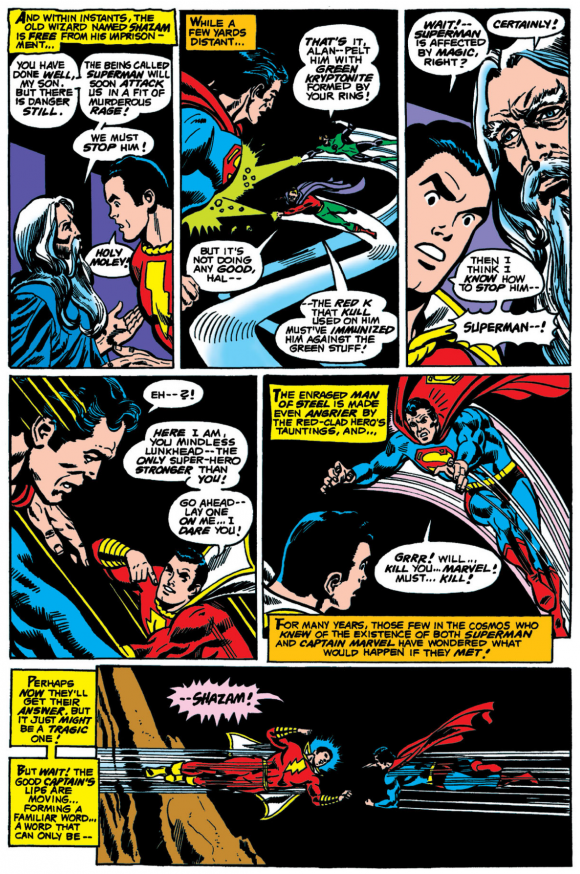
Issue #137, McLaughlin inks.
Along with big bad King Kull and a myriad of Marvels (Captain, Junior and Mary), and the wizard Shazam, the story makes good use of the old Fawcett catalog, including Bulletman and Bulletgirl, Spy Smasher, Ibis the Invincible, Mr. Scarlet and Pinky. And don’t forget there was also a full complement of JLAers and JSAers and their assorted villains running around as well. I can’t speak for Dick Dillin, but from the look of these issues, I’d say he took even Nelson’s obsession with detail in stride.
—
12. Justice League of America #147-148 (October-November 1977). For 1977, the JLA/JSA went where no annual crossover had gone before: into the 30th century world of the Legion of Super-Heroes. It was probably about time the groups met; the Legion had been introduced in 1958, almost two years before (or a thousand years after) the JLA’s debut. And what’s a millennium among friends anyway?
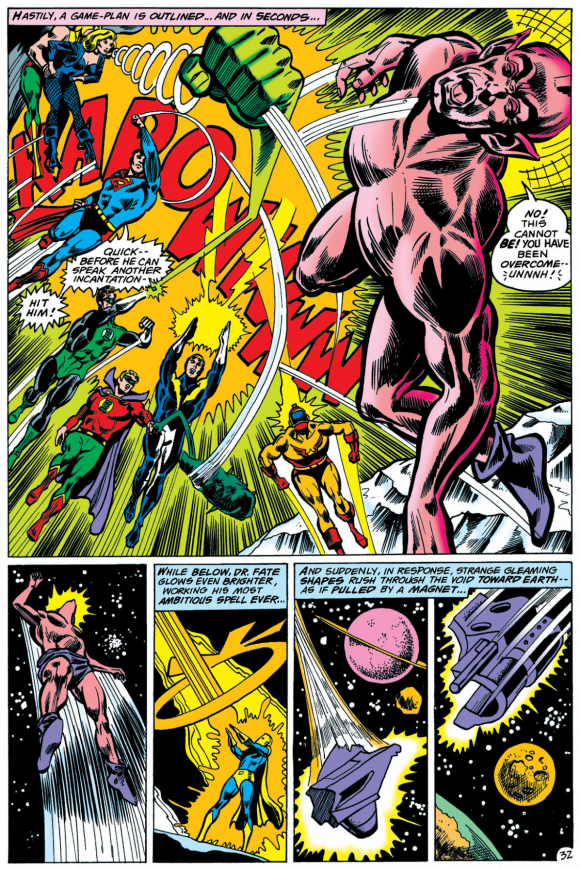
Issue #148, McLaughlin inks.
Once again, Dick Dillin deserved to be awarded a distinguished penciller medal. There were artists who refused LSH assignments because of the number and complexity of the characters. But the Legion plus the JLA plus the JSA plus whatever Mordru and his crew consisted of? I guess that was what Dick probably considered just another day at the drawing board.
—
13. Justice League of America #159-160 (October–November 1978). The writers had changed (several times), but just shy of 100 issues into his run on JLA, Dick Dillin was still going strong. He had become the Justice League artist to a generation of readers, just the way Mike Sekowsky had to me years earlier.
For “Crisis From Yesterday” and “Crisis From Tomorrow,” writer Gerry Conway used the Time Lord to dip into a collection of DC’s historically based heroes, including Jonah Hex, Viking Prince, Miss Liberty, Black Pirate and Enemy Ace to take on the Earth-One and Earth-Two super-teams.
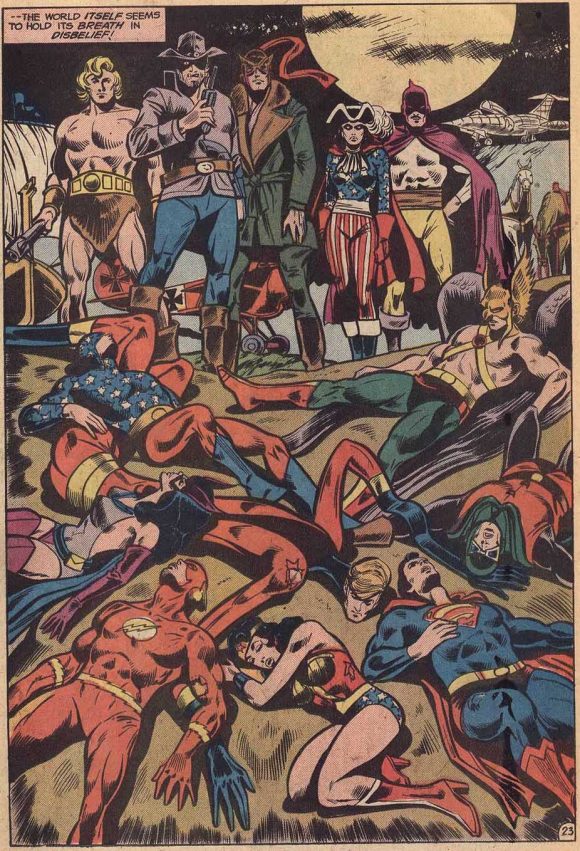
Issue #159, McLaughlin inks.
There didn’t seem to be anything Dillin couldn’t draw. His figures were muscular but never overinflated, his women beautiful and statuesque but firmly grounded in reality and anatomy. He could create convincing alien characters and landscapes, and his hardware was solid and functional. His Superman had power, his Batman mystery, his Green Arrow a swagger.
For all that, there was nothing flashy about Dick Dillin’s art, but anyone as good as he was didn’t need to show off.
—
MORE
— PAUL KUPPERBERG: My 13 Favorite MIKE SEKOWSKY Comics. Click here.
— PAUL KUPPERBERG: My 13 Favorite 1960s Comic Book Books. Click here.
—
PAUL KUPPERBERG was a Silver Age fan who grew up to become a Bronze Age comic book creator, writer of Superman, the Doom Patrol, and Green Lantern, creator of Arion Lord of Atlantis, Checkmate, and Takion, and slayer of Aquababy, Archie, and Vigilante. He is the Harvey and Eisner Award nominated writer of Archie Comics’ Life with Archie, and his YA novel Kevin was nominated for a GLAAD media award and won a Scribe Award from the IAMTW. Check out his new memoir, Panel by Panel: My Comic Book Life.
Website: https://www.paulkupperberg.net/
Shop: https://www.paulkupperberg.net/shop-1


December 17, 2020
I always suspected Cary Bates was evil
December 17, 2020
Cary wasn’t evil. He was just drawn that way.
December 19, 2025
LOL
December 17, 2020
I thought Wing was the “Seventh” soldier who died in JLA 102? Am I mistaken?
December 17, 2020
No, you’re right, it was Wing not Winged Victory. Also it was a three parter story, not a 2 part story. Come on Paul!!! I’m going to chalk that up to being too lazy to look it up and going by memory.
December 17, 2020
Thank you, Mr. Kupperberg, for this amazing article. Loved reading all of it.
December 17, 2020
The team ups were something to look forward to reading each year. That thrill is gone now that every issue is part of some “grand” event. My first crossover was “Earth X”.
I also just ordered my copy of JSA from Amazon. I love the JSA. I just wish the story had stayed fixed in the ‘40s.
December 17, 2020
Those Blackhawk covers have me really needing a reprint collection of same by Dillin. Paul, if you know the secret to getting DC to publish classic collections of choice, please put a bug in their ear on this one!
December 17, 2025
PS Artbooks has been publishing the Quality Blackhawk stories from the start. Currently they are on volume 18 which features solid Dick Dillin art from the early 50s.
December 17, 2021
My favorite was “Crisis on New Genesis” (Justice League of America Volume 1 # 183) – always saddened that Mr. Dillin was not able to finish that Crisis. But hey, George Perez.
February 10, 2022
Sad but of symmetry that his first issue and his last issue were both the first part of a JLA/JSA crossover.
December 18, 2021
One of the first comics I owned was JLA 83. It was exciting, and as you said, not padded, art wise. And yeah, Dillin is my go to JLA artist. The “Adult Robin” of Earth Two is a great concept–I just never liked Dillin’s costume, preferring the one from the later issues of All Star.
January 5, 2022
JLA #135-137 was the only time the Earth-2 Batman would appear in any of these JLA-JSA crossovers.
December 17, 2025
The Showcase Presents Blackhawk volume, featuring Dillin’s take on the characters, is one of the few Showcase black-and-whiters that I’ve hung on to. I was so disappointed to see Blackhawk included in the War Finest, because as you stated, the feature became an adventure strip. Holding out hope that someday Blackhawk will have its own Finest. Just color the Showcase volume, dang it!
Sure wish DC would also continue the Bronze Age JLA omni’s, so that we can see the rest of Dillin’s work there.
December 17, 2025
With the passage of time I think artists like Dick Dillin along with Irv Novick, Bob Brown, Jim Mooney and Don Heck are seen in a far different light than in their published time. Original art prices certainly reflect a reevaluation of their talent as opposed to flashier artists like Kirby, Romita, Kane, Inantino, Windsor-Smith or Wrightson.
December 17, 2025
One of my favorite crossovers involved the JLA and the JSA Teaming up with the All Star Squadron in Earth Two’s past to take on Per Degaton.
December 17, 2025
If only we could get Paul or Roy (Thomas) to write another prose story. I’d love a classic spin of the classic WWII era, pre-crisis re-writes.
>> my recently published Justice Society of America novel…
>>
At a minimum, Paul, where’s the sequel?
December 19, 2025
I love the JSA! As I’ve posted before my first exposure to them was in JLA 83 which I picked up in a used store a couple of years after it came out. A few months later I found the Hundredth issue of JLA on the spinner rack and I was off and running as a diehard fan! I could empathize with the “growing older” heroes in the JSA/All Star stories I read in High School in the Seventies as I was surrounded by ageing family members. And now that I’m in my sixties believe me I can identify with them myself! Dick Dillin’s artwork was simply masterful. Never for a moment did I doubt that those costumed heroes actually looked like that!